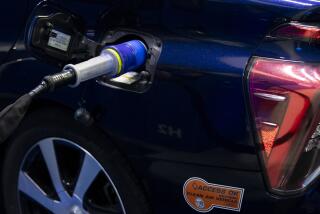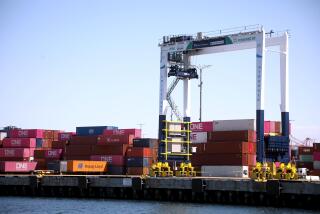Family in Redondo Beach to Evaluate Hydrogen Car
- Share via
No-pollution cars powered by hydrogen fuel cells are at least a decade away for most people -- but not for one Southern California family.
In a long-term road test, John Spallino, his wife and two daughters will begin leasing a four-seat Honda FCX today to get them to work, school and anywhere else they want to roam.
The Spallinos will provide reports about the car’s performance to Honda as part of the auto industry’s first private test of the promising technology that produces only one byproduct: water clean enough to drink.
“Maybe this is the technology of the future. Maybe it isn’t,” said Spallino, a financial officer who plans to use the FCX for his 80-mile round-trip commute from his home in Redondo Beach to Irvine.
“But if I can be part of the evolution of this technology, that would be a lot of fun,” he said.
The test could give a push to pollution-free cars, said Lindsay Brooke, a senior analyst for CSM Worldwide, an automotive forecasting company.
“Its impact really is in being one small but very meaningful step in the road toward these vehicles being a production reality,” Brooke said.
Honda, however, won’t say when it might mass-market the FCX, which is now built one by one without the economic efficiency of an assembly line.
Honda chose the Spallinos for the test in part because they own a Honda Civic GX powered by natural gas and are accustomed to finding fueling stations that provide alternatives to gasoline.
The family will pay $500 a month to lease the FCX. That includes maintenance and insurance on the car that cost Honda more than $1 million to design and build using technology that turns hydrogen and oxygen into electricity.
Government agencies and universities have tested hydrogen vehicles for Honda and other automakers in the past, but the FCX will be the first hydrogen fuel cell car in private hands.
It meets all government safety standards and drives like a regular car, though its electric hum is quieter than a gas engine. The FCX accelerates and maintains speeds comparable to gasoline-powered vehicles.
One difference can be found in the trunk. The Spallinos will have to pack light because their new car has less than a third of the trunk space of a typical car.
But the biggest difference is in the fuel tank. The FCX uses hydrogen gas instead of gasoline and can go only about 190 miles on a tank of fuel.
There are now about 30 hydrogen-fueling stations across the country, with more than half of them in California. But Spallino counts at least four on his way to work, including one at Honda’s U.S. headquarters in Torrance and another at Los Angeles International Airport.
President Bush, Gov. Arnold Schwarzenegger and others say cars run by converting hydrogen to electricity will one day wean the nation of its oil dependence while reducing air pollution.
Environmentalists counter that some automakers are using that promise to avoid improving fuel-efficiency in current models.






